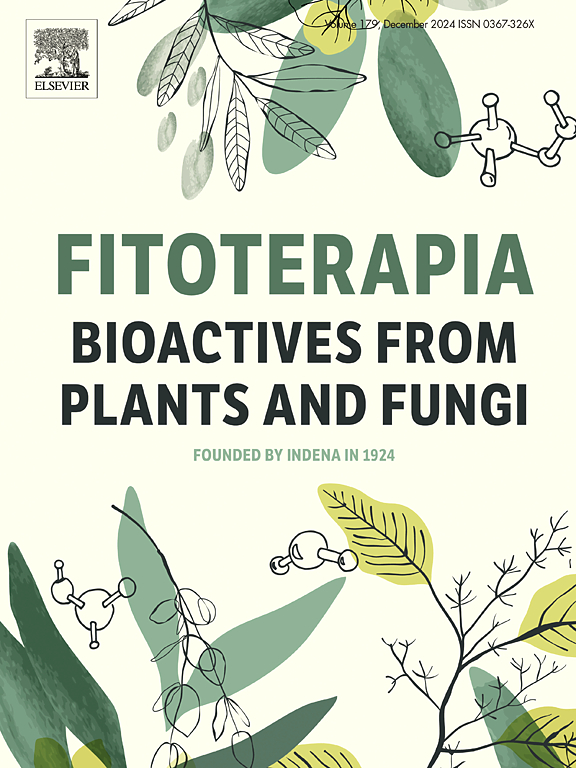Studies on the safety and irritability of eco-friendly extracts of Pterocaulon balansae Chodat (Asteraceae) standardized in coumarins aiming at topical application
IF 2.6
3区 医学
Q3 CHEMISTRY, MEDICINAL
引用次数: 0
Abstract
Species of Pterocaulon (Asteraceae) genus have been used in folk medicine to treat skin diseases of different origins. However, only few studies evaluated the toxicity of species of this genus. This study aims to evaluate the safety and irritability of Pterocaulon balansae extracts intended for topical application. Three extracts of P. balansae - aqueous, hydroalcoholic and CO2 supercritical - were prepared and standardized in coumarins by ultra-fast liquid chromatography. The toxicity profile and cell death mechanism were evaluated in keratinocytes and fibroblasts, the irritability through the hen's egg test on the chorioallantoic membrane (HET-CAM), and the mutagenicity by Salmonella/microsome test. The coumarin profile was similar in all extracts with a higher coumarin content for the supercritical CO2 extract. Whatever the extract, a reduction in viability and proliferation was observed in human keratinocytes (HaCaT) and fibroblasts (MRC5) by MTT and SRB at the concentrations of coumarins >12.5 μg/mL. Flow cytometry with annexin V-FITC/propidium iodide staining indicated necrosis as the main mechanism of cell death. The HET-CAM assay showed that extracts were non-irritating at concentrations up to 25 μg/mL of coumarins, but the CO2 supercritical extract was highly irritating at 100 μg/mL. Such extract also exhibited the highest mutagenicity in the Ames test, even after metabolic activation, which may be related to its elevated levels of two key coumarins: 5-methoxy-6,7-methylenedioxy coumarin and 5,6-dimethoxy-7-(2′,3′-epoxy-3′-methylbutyloxy) coumarin. These findings suggest that the concentration and composition of coumarins in P. balansae extracts influence their toxicity, providing insights regarding its safety for developing coumarin-based skin treatments.

面向外用香豆素标准的环保香豆素提取物的安全性和刺激性研究。
翼龙属植物已被用于民间医学治疗不同来源的皮肤病。然而,只有少数研究评估了该属物种的毒性。本研究旨在评价外用翼龙提取物的安全性和刺激性。采用超快速液相色谱法制备了三种香豆素提取物——水提物、水醇提物和CO2超临界提物。对角化细胞和成纤维细胞的毒性和细胞死亡机制进行了评价,对绒毛膜-尿囊膜(HET-CAM)进行了鸡蛋试验,并对沙门氏菌/微粒体试验进行了致突变性评价。超临界CO2萃取物中香豆素含量较高,各萃取物中香豆素含量相似。在香豆素12.5 μg/mL浓度下,MTT和SRB均能降低人角质形成细胞(HaCaT)和成纤维细胞(MRC5)的活力和增殖。膜联蛋白V-FITC/碘化丙啶染色流式细胞术显示坏死是细胞死亡的主要机制。HET-CAM实验表明,香豆素提取物在浓度为25 μg/mL时无刺激性,而CO2超临界提取物在浓度为100 μg/mL时具有很强的刺激性。在Ames试验中,即使在代谢激活后,该提取物也表现出最高的诱变性,这可能与其两种关键香豆素的含量升高有关:5-甲氧基-6,7-亚甲二氧基香豆素和5,6-二甲氧基-7-(2',3'-环氧-3'-甲基丁氧基)香豆素。这些发现表明,香豆素提取物中的香豆素浓度和成分影响其毒性,为开发以香豆素为基础的皮肤治疗提供了安全性方面的见解。
本文章由计算机程序翻译,如有差异,请以英文原文为准。
求助全文
约1分钟内获得全文
求助全文
来源期刊

Fitoterapia
医学-药学
CiteScore
5.80
自引率
2.90%
发文量
198
审稿时长
1.5 months
期刊介绍:
Fitoterapia is a Journal dedicated to medicinal plants and to bioactive natural products of plant origin. It publishes original contributions in seven major areas:
1. Characterization of active ingredients of medicinal plants
2. Development of standardization method for bioactive plant extracts and natural products
3. Identification of bioactivity in plant extracts
4. Identification of targets and mechanism of activity of plant extracts
5. Production and genomic characterization of medicinal plants biomass
6. Chemistry and biochemistry of bioactive natural products of plant origin
7. Critical reviews of the historical, clinical and legal status of medicinal plants, and accounts on topical issues.
 求助内容:
求助内容: 应助结果提醒方式:
应助结果提醒方式:


